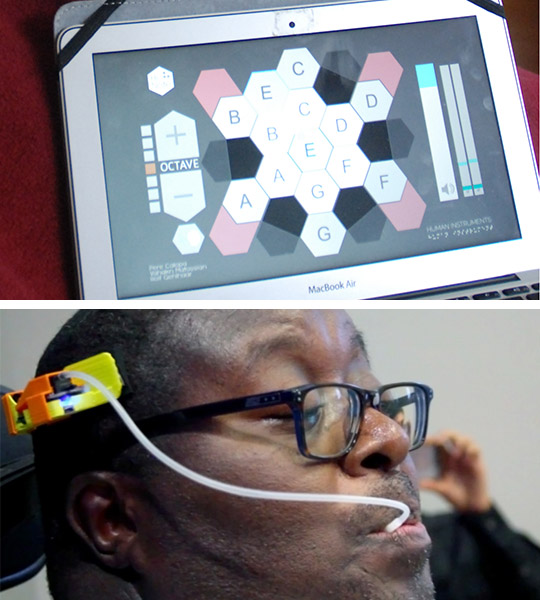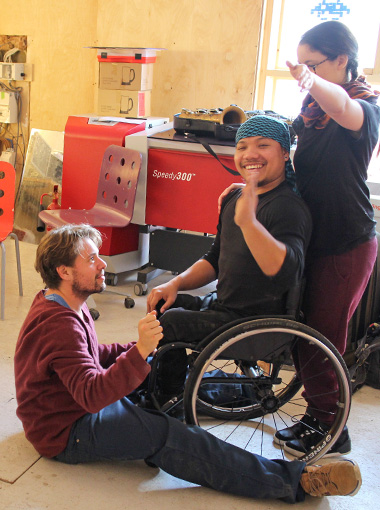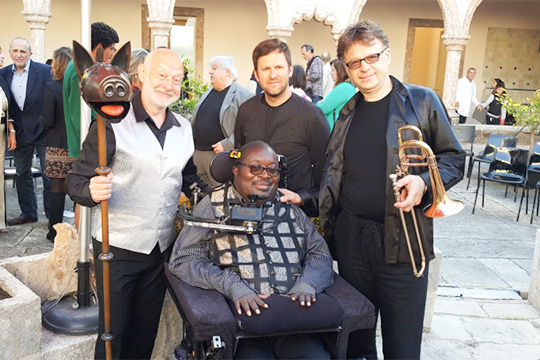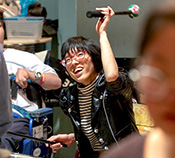Music creation should be possible for everyone, no matter the physical challenge.
(Part 2)
Vahakn Matossian / Designer and Inventor
Basking musicians with disabilities in the limelight.
Human Instruments develops musical instruments for people with limited physical abilities. The company’s designer Vahakn Matossian follows a simple policy: create musical instruments for serious professional musicians rather than therapeutic gadgets. We trace the path that brought him to the Human Instruments and focus on the company’s future development.
Simple technology delivers great benefits to players.
Let me present some of our devices from Human Instruments. We created the first one for a musician who is paralyzed from the neck down. The monitor displays a panel of different notes, or keys. An array of sensors attached to the player’s head enables the musician to select keys on the monitor by moving his head. Once a key is selected, the player blows into the mouthpiece to sound out the note. Through repetition, the body learns the positions of the keys and the head movements to select the desired notes. In time, the player masters the device just as he or she would a standard musical instrument.

We also invented a conductor's baton that visually impaired musicians can follow. As the conductor conducts, a transmitter embedded within the baton sends out signals representing its movement, speed, and dynamics to a receiver worn by the musician. With this device, a visually impaired musician can feel nuances of tempo and expression dictated by the conductor during a musical performance.
The other day at a music festival in Stockholm, I met a young musician who lacked the ability to control his arms. He used an iPad to play his music, operating it with his nose and mouth with great skill, but with difficulty. I modified the device by adding a large button to activate the looping function more easily. This simple idea has helped him significantly with his creative activities, and his sound is much improved. The devices I make at Human Instruments are logical. By keeping them logical I can adapt them more flexibly to various types of impairment.
The joy comes from creating things that people truly need.
I have changed in my approach to creating. Before I designed for ordinary commissions. Today I create for those who need specially customized instruments in order to play music. I am producing things that people truly need. For the moment mass production isn’t in the game plan; my focus is designing for individuals with very specific needs. Ultimately, my designs satisfy me as a creator bringing new things into the world.
There is another important guiding principle in the project: to see music not merely as a therapeutic pursuit. My ambition is to help more and more musicians with disabilities succeed as professional music creators, performing on par with those without disabilities. This is the core value of Human Instruments. If we see musicians in wheelchairs or with missing limbs perform well on television or at concerts as often as we see ordinary musicians, the world of music will be a richer place.

Changing the reality by being noticed in the world.
Creating original devices is not so difficult to pursue on a technical level. The real challenge comes in fundraising and promoting my initiatives. Musicians with disabilities still have very few opportunities to play in front of audiences, so their presence in society goes largely unrecognized. I strive to bring about a world where people with disabilities can thrive as professional musicians and all of society knows it. Professional musicians should be appreciated for their skills and abilities without the stigma of the “disability” label. If they perform at the level of professionals, the perceptions of their place in society will change.
When musicians with disabilities perform more in public, other people with the same or similar disabilities see that they too have opportunities to express themselves in society. For someone like me who grew up cocooned in a world of music, life without music is unthinkable. It pains me to see some people forced into such a life by physical impairments. I hope to brighten up their worlds by providing my full support. One thing is certain: music can change people’s lives.

- Vahakn Matossian / Designer and Inventor
- London-based designer Vahakn Matossian grew up in a family of musical talents and has become a successful DJ musician himself. Vahakn’s involvement in an orchestra his father helped organize for people with disabilities inspired him to start “Human Instruments”- a company that develops musical devices that even persons with heavy physical challenges can play.
Interview Date:



